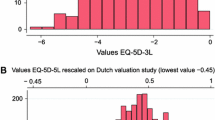Abstract
Objective
Different variants of time trade-off (TTO) have been employed to elicit health state preferences and to create value sets for preference-based instruments. We compared composite TTO (cTTO) with traditional TTO (tTTO) in valuing severe EQ-5D-5L health states.
Methods
cTTO uses tTTO to elicit values for health states better than dead and the lead-time TTO for states worse than dead. Eighteen severe states were valued using both cTTO and tTTO. Participants meeting predefined inconsistency criteria were excluded from the analyses. Histograms were used to examine the distributions of cTTO and tTTO values. Mean difference between the cTTO and tTTO values was calculated. Bland–Altman plots were used to examine the agreement between the cTTO and tTTO values for each health state. We used a logistic mixed effects model with random intercepts to identify variables that were associated with the directional change between the two TTO values.
Results
A total of 1024 participants were included in the analysis with the mean age (SD) being 47.1 (17.4) years and 54.9 % female. For cTTO, 25 % of the values clustered at zero and there were few values between 0 and −0.5. In contrast, tTTO had fewer values at zero and more falling between −0.5 and 0. The distribution of positive values was similar between cTTO and tTTO. For worse than dead health states, the cTTO values tended to be higher than the tTTO values. In the logistic mixed effects model, those who did not agree that it was easy to understand the cTTO questions more likely changed from positive values in cTTO to zero or negative values in tTTO or change from zero cTTO values to negative values in tTTO compared with those who agreed (odds ratio 1.314, p = 0.037).
Conclusion
cTTO is an appealing technique in eliciting health state preferences, but further evidence is needed for its performance in valuing EQ-5D health states on a wide spectrum of health state severity.


Similar content being viewed by others
References
Al Sayah F., Mladenovic, A., Gaebel, K., Xie, F., & Johnson, J. A. (2015). How dead is dead? Qualitative findings from participants of combined traditional and lead-time time trade-off valuations. Quality of Life Research, 25(1), 35–43.
Attema, A. E., Versteegh, M. M., Oppe, M., Brouwer, W. B., & Stolk, E. A. (2013). Lead time TTO: Leading to better health state valuations? Health Economics, 22, 376–392.
Bland, J. M., & Altman, D. G. (1986). Statistical methods for assessing agreement between two methods of clinical measurement. The Lancet, 1, 307–310.
Devlin, N. J., Tsuchiya, A., Buckingham, K., & Tilling, C. (2011). A uniform time trade off method for states better and worse than dead: Feasibility study of the ‘lead time’ approach. Health Economics, 20, 348–361.
Dolan, P. (1997). Modeling valuations for EuroQol health states. Medical Care, 35, 1095–1108.
Herdman, M., Gudex, C., Lloyd, A., Janssen, M., Kind, P., Parkin, D., et al. (2011). Development and preliminary testing of the new five-level version of EQ-5D (EQ-5D-5L). Quality of Life Research, 20, 1727–1736.
Janssen, B. M., Oppe, M., Versteegh, M. M., & Stolk, E. A. (2013). Introducing the composite time trade-off: A test of feasibility and face validity. The European Journal of Health Economics, 14(Suppl 1), S5–S13.
Lamers, L. M., McDonnell, J., Stalmeier, P. F., Krabbe, P. F., & Busschbach, J. J. (2006). The Dutch tariff: Results and arguments for an effective design for national EQ-5D valuation studies. Health Economics, 15, 1121–1132.
Pullenayegum, E., & Xie, F. (2013). Scoring the 5-Level EQ-5D: Can latent utilities derived from a discrete choice model be transformed to health utilities derived from time tradeoff tasks? Medical Decision Making, 33, 567–578.
Robinson, A., & Spencer, A. (2006). Exploring challenges to TTO utilities: Valuing states worse than dead. Health Economics, 15, 393–402.
Shaw, J. W., Johnson, J. A., & Coons, S. J. (2005). US valuation of the EQ-5D health states: Development and testing of the D1 valuation model. Medical Care, 43, 203–220.
Torrance, G. W. (1986). Measurement of health state utilities for economic appraisal. Journal of Health Economics, 5, 1–30.
Xie, F., Gaebel, K., Perampaladas, K., Doble, B., & Pullenayegum, E. (2014). Comparing EQ-5D valuation studies: A systematic review and methodological reporting checklist. Medical Decision Making, 34, 8–20.
Acknowledgments
This project was supported by an operating grant from the Canadian Institutes for Health Research (#MOP 111076) and funding support from the EuroQol Foundation. Feng Xie and Eleanor Pullenayegum are supported by Canadian Institutes of Health Research New Investigator Awards (2012–2017). Jeffrey Johnson is a Senior Health Scholar with Alberta Innovates Health Solutions.
Author information
Authors and Affiliations
Corresponding author
Additional information
On behalf of the Canadian EQ-5D-5L Valuation Study Group.
Appendix: The Canadian EQ-5D-5L Valuation Study Group
Appendix: The Canadian EQ-5D-5L Valuation Study Group
Principal Investigators: Drs. Xie F (McMaster University) and Johnson JA (University of Alberta); Co-Investigators: Drs. Bansback N, Bryan S (University of British Columbia), Ohinmaa A (University of Alberta), Poissant L (University of Montreal), Pullenayegum E (Hospital for Sick Children); Research Coordinator: Kathy Gaebel (McMaster University); Research Assistants: Samantha Pollard and Lidia Engel (University of British Columbia), Serena Humphries and Fatima Al Sayah (University of Alberta), Touria Addou (University of Montreal).
Rights and permissions
About this article
Cite this article
Xie, F., Pullenayegum, E., Gaebel, K. et al. How different are composite and traditional TTO valuations of severe EQ-5D-5L states?. Qual Life Res 25, 2101–2108 (2016). https://doi.org/10.1007/s11136-016-1242-5
Accepted:
Published:
Issue Date:
DOI: https://doi.org/10.1007/s11136-016-1242-5




